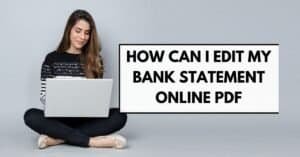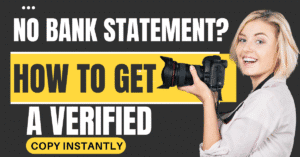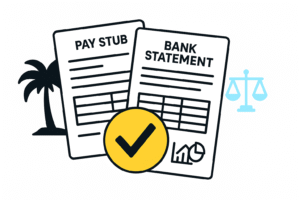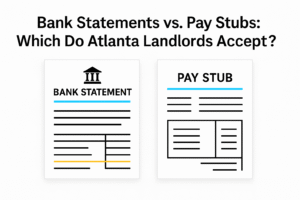Last updated: September 2025
When you apply for a lease, mortgage, or visa, the same question pops up: can your bank statements alone prove what you earn? In some settings, a statement with regular deposits works; in others, lenders and governments require pay stubs, tax forms, or bank letters. This guide explains where the bank statements proof of income approach works, where it doesn’t, and how to prepare documents the right way.
Related Entities & Terms:
- Bank statement, account summary, deposit ledger
- Pay stub, payslip, earning statement
- W‑2 (US), 1099 (US), T4 (Canada), Notice of Assessment (NOA)
- Loan underwriting, tenant screening, mortgage pre‑approval
- Consumer Financial Protection Bureau (CFPB), Federal Trade Commission (FTC), Internal Revenue Service (IRS)
- Financial Conduct Authority (FCA), Financial Consumer Agency of Canada (FCAC), Canada Revenue Agency (CRA)
- Anti‑Money Laundering (AML) rules, KYC (Know Your Customer)
- Document redaction, data privacy, electronic statements
Throughout this article, we link to official resources and to our in‑depth guides (for example, comparisons of pay stubs vs bank statements and practical tips for cross‑checking pay stubs and bank statements). Our goal is to help you submit clean, compliant documents that match what reviewers expect.
Are bank statements legally accepted as proof of income?
Short answer: yes, but the details matter. Acceptance varies by purpose and jurisdiction, and statements often need support from pay records or tax forms. Below is a plain‑English summary of how authorities view bank statements proof of income in the US, UK, and Canada.
United States: Federal and state programs frequently list bank statements as acceptable supporting evidence when verifying household income, especially to show regular deposits. For lending, underwriters usually pair statements with pay stubs, W‑2s, 1099s, or tax transcripts. A statement that clearly shows periodic payroll deposits—when matched to an employer pay stub—often satisfies rental and many consumer‑credit checks. However, higher‑risk lending and mortgages rely on tax documentation, employer verification, and automated income checks in addition to statements.
United Kingdom: UK guidance allows applicants to evidence funds using bank statements and/or payslips, typically covering recent months. Where you must prove maintenance funds, statements should show the account holder’s name, the bank’s name, the date issued, and that the balance met the requirement across the 28‑day period. Electronic statements are acceptable if they include all required details. For some routes, a letter from the bank may be requested in addition to statements.
Canada: For Express Entry, IRCC requires an official letter from your financial institution that lists account numbers, opening dates, current balances, and six‑month average balances. Bank statements alone are often used for temporary resident or work applications to demonstrate ongoing funds, but they usually support—rather than replace—an official bank letter or tax evidence.
Across all three jurisdictions, the pattern is consistent: bank statements can corroborate income and demonstrate liquidity, but regulators and lenders prefer to triangulate with employer documents and tax records. If your deposits are irregular or lack clear descriptors, add context with invoices, contracts, or an employer letter.

Which edits to bank statements are allowed?
Formatting, not fabrication. You can improve clarity and protect privacy as long as you leave financial facts untouched. The following edits are widely accepted by landlords, lenders, and program administrators.
Redaction for privacy: It is reasonable to hide sensitive data such as your full account number, home address, debit card numbers, or direct‑debit references. Leave your name, bank name, statement dates, partial account number (e.g., last 4 digits), and balances visible. Proper redaction lowers identity‑theft risk without obscuring what reviewers need to see.
Improving legibility: Downloaded statements sometimes print light, scatter across pages, or include large blank areas. Professional cleanup can raise contrast, align margins, correct rotation, and combine pages into a single, bookmarked PDF. You may add non‑destructive annotations—callouts that circle payroll deposits or refer reviewers to matching pay stubs or invoices. None of these steps change amounts, dates, payees, or running balances.
Export and conversion: Converting HTML statements or CSV exports to a consistent PDF is fine. So is compressing oversized files, inserting page numbers, and ordering months chronologically. If you extract only the deposit pages for a submission, keep the original, full statements on hand and ensure page numbering and totals remain intact.
Explanation notes: When deposits include tips, gig earnings, or transfers from a business account, attach a brief cover note. Reference the related invoice numbers or 1099s, explain any seasonality, and clarify the relationship between accounts. This narrative sits outside the statement and does not alter transaction data.
Good‑practice add‑ons (optional): Include a one‑page index listing which documents cover which dates, and a reconciliation table mapping pay stubs or invoices to the specific deposit lines on your statements. Reviewers appreciate a clear roadmap.
What bank statement edits are illegal?
Any change that alters facts is off‑limits. Falsifying bank statements—by fabricating transactions or manipulating balances—is fraud. Agencies and lenders employ digital forensics and cross‑checks, so even “small” tweaks are risky and unlawful.
Changing amounts, dates, or payees: Do not modify deposit values, transaction dates, or employer/client names. These fields are core to underwriting decisions and AML reviews. Edits here misrepresent your financial position and are treated as false statements.
Inserting or deleting transactions: Adding fake deposits, deleting overdraft fees, or removing a bounced‑payment record is falsification. Even rounding balances to look “neater” can be construed as intent to mislead if it changes reported figures.
Replacing pages or mixing accounts: Swapping pages from other months or different accounts breaks the internal controls many banks embed (page counts, hash codes, and sequencing). Reviewers often spot gaps like “Page 3 of 5” missing or a running balance that does not reconcile.
Altering logos or letterhead: Copy‑pasting bank branding to unauthentic documents, or editing official letters to change balances, violates fraud and intellectual‑property laws. These changes are traceable in metadata.
Consequences: Submitting falsified statements can lead to immediate denial, contract termination, civil penalties, and criminal exposure. In the US, knowingly making false statements to influence a lender or federal agency is a crime that can result in fines and imprisonment. The UK and Canada impose comparable sanctions, including long bans on applications. Always choose transparency and context over manipulation.
When do bank statements work and when don’t they?
Context is everything. Bank statements can confirm regular income inflows and available funds, but they rarely replace pay records or tax documents entirely. Treat them as part of a package—especially when using the bank statements proof of income strategy.
Rental applications and tenant screening
Most landlords request two to three months of statements to verify cash‑flow stability. If you’re salaried, include your latest pay stubs so the landlord can match net‑pay deposits to the stub amounts. If you earn variable income (tips, gig work, commission), add invoices, platform statements (e.g., rideshare dashboards), or a short employer/contractor letter.
Mini‑scenario: You receive £2,100 net on the 28th of each month and your statements show “PAYROLL ACME LTD” on those dates. Attach the corresponding payslips with the same employer name and deposit amounts. A short note can explain a one‑off bonus or a second job’s smaller deposits.
What helps: clean scans, clear employer descriptors, and a debt‑to‑income ratio that aligns with rent. What hurts: frequent overdrafts without explanation, unexplained large cash deposits, and missing pages.
Loans and mortgages
Lenders use statements to confirm that stated income actually arrives and to assess spending and obligations. Expect to provide pay stubs and W‑2s/T4s, and for self‑employed borrowers, tax returns and year‑to‑date profit‑and‑loss statements. Some small personal‑loan providers may rely on statements more heavily, but mortgages and higher‑limit credit almost always require tax evidence.
Tip: If your payroll description is generic (e.g., “ACH CREDIT”), ask HR whether they can include the employer name in the descriptor. If not, annotate your submission to link each pay stub to the correct deposit line.
Small Business Administration (SBA) and government programs
Government programs often accept statements as supporting evidence of income and cash flow. You will usually need to supply tax returns, employer documents, and sometimes profit‑and‑loss statements. Treat statements as corroboration rather than the sole proof to reduce back‑and‑forth with reviewers.
Immigration and visas
For UK routes that require maintenance funds, provide statements covering the relevant period (commonly 28 days) with all mandatory details present; in some cases a bank letter is also advisable. For Canada’s Express Entry, statements can support but do not replace the official bank letter specifying balances and averages. Always check the specific program’s checklist and timing windows.
Self‑employed and gig workers
If you don’t receive traditional pay stubs, build a straightforward income dossier:
- Monthly bank statements showing deposits and core expenses
- Invoices or contracts that map to those deposits
- 1099s (US) or T4A slips (Canada), if issued
- Recent tax filings or a Notice of Assessment (NOA)
- A one‑page summary explaining seasonality, customer concentration, and payment terms
Mini‑scenario: A freelance designer invoices US$3,000–$5,000 monthly. Their statements show deposits from two major clients; the package includes the matching invoices, 1099s, and a short note that explains a seasonal lull in July. This clarity helps underwriters reconcile deposits to actual work performed.
Other contexts: insurance, education and grants
Scholarships, grants, and insurance hardship programs vary widely in what they accept. Many welcome statements that demonstrate recent deposits and current balances but still ask for tax transcripts or employer letters. When unsure, submit statements plus the strongest available pay or tax documentation to pre‑empt follow‑up requests.
Bottom line: bank statements make your application stronger when they confirm the story told by your pay and tax records. They are seldom the only proof required, especially for higher‑risk or long‑term obligations.
How does FinancialDocsProvider.com ensure compliance?
We organise and verify; we never fabricate. Our role is to make your documents clearer, more complete, and easier to review—without changing a single financial fact. Here is our compliance‑first workflow.
1. Intake and document collection: You complete a short questionnaire so we understand the review context (rental, loan, immigration, grant). You then upload PDF statements, pay stubs, tax forms, and any employer or accountant letters. We never request online‑banking credentials—only copies of official documents.
2. Reconciliation and cross‑checking: We map deposits on your statements to pay stubs, invoices, or contracts and flag mismatches for clarification. Where useful, we prepare a simple reconciliation table that lists document date, deposit date, and amount so underwriters can see the link at a glance.
3. Formatting and redaction: We enhance readability, merge months in order, add bookmarks by month, and insert page numbers. Sensitive data (full account numbers, personal identifiers) is redacted carefully while leaving required details visible. If documents come from multiple accounts or currencies, we label each section and, where appropriate, add an exchange‑rate note for context.
4. Cover note and explanation: For irregular income or one‑off deposits (bonuses, contract prepayments), we draft a brief cover note that references the supporting documents. The note clarifies, but never changes, the underlying data.
5. Delivery: We deliver a neat package—cleaned statements plus originals—through a secure portal. You also receive a checklist tailored to your use case, so you know exactly what to submit and in what order. Pricing is transparent; see our proof of income editing and pricing pages for details.
Our process balances speed with diligence. We focus on presentation and traceability so your documents tell a clear, truthful story that aligns with regulatory expectations.
What’s a compliance checklist for submitting bank statements?
Use this step‑by‑step list before you submit. It aligns common lender and government expectations and helps you avoid avoidable delays.
- Gather the correct period: Obtain two to six months of statements, depending on requirements. For UK visa maintenance, ensure the 28‑day rule is met.
- Verify your personal details: Check that your name, partial account number, bank name, and statement dates appear on each page. For Canada’s Express Entry, request the required bank letter showing account numbers, opening dates, current balances, and six‑month averages.
- Match deposits to documents: For each deposit, have a pay stub, invoice, contract, or benefits letter that explains the source. Create a simple mapping table if deposits are frequent or identical in amount.
- Redact sensitive data: Hide full account numbers and personal identifiers, leaving the last digits visible for continuity. Avoid redactions that cover dates, balances, or payee names.
- Check completeness: Include all pages, even if some are blank or “This page intentionally left blank.” Missing pages prompt rejections.
- Mind the recency window: Many reviewers require recent statements (often within 30–60 days). Replace outdated PDFs before submitting.
- Explain anomalies: Prepare a brief note for large cash deposits, transfers from savings, or occasional overdrafts. Context prevents unnecessary denials.
- Include supporting forms: Add pay stubs and tax documents (W‑2s, 1099s, T4s, NOAs). Self‑employed applicants should include a current profit‑and‑loss statement and recent returns.
- Use secure delivery: Submit via encrypted portals or secure email. Avoid sending statements via unencrypted email or messaging apps.
- Keep originals: Retain the full, unedited statements and any bank letters so you can supply them if requested.
Following this checklist shows reviewers you take compliance seriously and reduces back‑and‑forth requests for clarification.
What are common red flags and mistakes?
Preventable issues derail otherwise strong applications. Watch for the following and address them proactively with explanations or supporting documents.
- Inconsistent deposit patterns: Wide month‑to‑month swings without context raise questions. Add a note explaining seasonal work, commission timing, or parental‑leave gaps.
- Missing pages or broken pagination: Banks often print “Page X of Y.” If Y is five and only four pages are submitted, reviewers assume information is missing. Always include the full set.
- Obvious visual edits: Cropped logos, mismatched fonts, or blurred regions look suspicious. Use consistent formatting and keep metadata intact.
- Unregulated or unfamiliar institutions: Some reviewers reject statements from fintechs that lack clear regulatory oversight or insurance. When in doubt, include statements from a mainstream, regulated bank or add a bank letter.
- Out‑of‑date documents: Submitting statements outside the program’s timing window can lead to automatic denial. Replace files if they are more than 30–90 days old, depending on the context.
- High debt load or frequent overdrafts: Regular overdrafts, payday‑loan deposits, or gambling transactions trigger deeper scrutiny. Provide context and demonstrate improved cash management if applicable.
- Unexplained large transfers: Transfers between your own accounts are fine, but label them. If funds came from family or a business account, explain the source and purpose.
Anticipating these issues—and addressing them upfront—helps reviewers focus on the merits of your application instead of chasing document gaps.
Where can I find official guidance and further reading?
Start with primary sources. The links below outline income‑verification standards, fraud rules, and document requirements. We also include helpful internal guides for side‑by‑side comparisons and formatting tips.
- U.S. Department of the Treasury – Income Verification Guidance: Lists acceptable documents, including bank statements, for verifying household income.
- U.S. Department of Justice – False Statements (18 U.S.C. § 1014): Explains that knowingly making false statements to influence lenders or federal agencies is a crime.
- GOV.UK – Financial evidence for sponsored or endorsed work routes: Describes how bank statements and payslips can prove funds.
- Canada.ca – Proof of funds for Express Entry: Outlines the requirement for bank letters detailing account balances over six months.
- CFPB – Documents you need for a mortgage: Practical overview of common mortgage documentation, including bank statements.
- FTC – Risks of fake pay stubs and bank statements: Consumer‑protection guidance on document fraud.
- IRS – Get Transcript: How to obtain official tax transcripts that commonly accompany income verification.
- Our guides: pay stub vs bank statement, cross‑checking pay stubs and statements, and legal editing of bank statements.
- Need help? Review our services, check our pricing, read about our process, or contact our team for tailored support.
FAQs
Below are concise answers to the questions we hear most about using bank statements during income verification. Requirements change, so check the latest program or lender checklist before you apply.
Can bank statements alone prove my income for a rental application?
Bank statements can demonstrate regular deposits and available funds, but most landlords also want pay stubs or an employer letter. Combining statements with pay stubs lets them match deposits to earnings and reduces the risk of rejection.
How many months of bank statements do lenders usually require?
For rentals and small loans, two to three months is common. Mortgages or business loans often require three to six months. Immigration authorities in the UK and Canada commonly refer to 28 days and six months, respectively.
Is it legal to hide my account number on a bank statement?
Yes. Redacting part of your account number, address, or other sensitive information is permitted. Leave enough digits to match pages and demonstrate continuity across documents.
What happens if I submit a falsified bank statement?
Submitting altered statements is considered fraud. In the US, making false statements to influence a lender or federal agency is a crime that can result in fines and imprisonment. Similar penalties apply in the UK and Canada. Your application will likely be denied, and you may face long‑term consequences.
Do self‑employed workers need more than bank statements to prove income?
Yes. Self‑employed individuals should provide bank statements along with invoices, 1099s or T4A slips, tax returns, and a brief summary of business income. This package demonstrates both the source and consistency of your earnings.
Need accurate, reliable financial documents fast? Contact FinancialDocsProvider.com now.
Author: Ahmed is a financial documentation specialist with years of experience helping renters, borrowers, and entrepreneurs prepare compliant income packages. Learn more about our process and how our team ensures your documents meet legal and lender standards.








Add comment